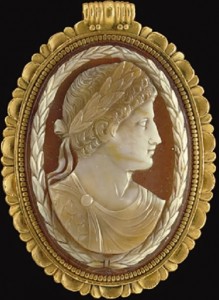Sometimes I wish I had never found out about how prevalent looted goods are in the antiques trade. Browsing an auction catalog of gorgeous historical pieces I could never afford used to be purely pleasurable. Now a pall is cast on every lot that has no record of ownership prior to 1970, and oh man are they legion. From my experience, they’re the vast majority of artifacts on sale.
 The latest catalog to make me drool and sigh is from an upcoming Christie’s sale. On December 11th, 179 pieces of ancient jewelry ranging from 3700-year-old engraved Minoan gemstones to an early 4th century sardonyx cameo of the Emperor Constantine will go on the block.
The latest catalog to make me drool and sigh is from an upcoming Christie’s sale. On December 11th, 179 pieces of ancient jewelry ranging from 3700-year-old engraved Minoan gemstones to an early 4th century sardonyx cameo of the Emperor Constantine will go on the block.
I love jewelry and I really, really love ancient jewelry, so of course I go check out the offerings, and the first things listed are 57 engraved Minoan gemstones dating to 1700-1450 B.C. All 57 of them come from a “Swiss private collection”.
Swiss private collections are like the antiquities market version of the Canadian girlfriend you met at camp. Sure, it could be genuine, but it’s been used as a front too many times to be taken at face value. None of these beautiful and precious Minoan talismans were published before 1980, which is another red flag.
Then there’s the no-name not-even-a-country provenance, like the 3rd c. A.D. Roman onyx cameo which Christie’s says is the “THE PROPERTY OF A EUROPEAN GENTLEMAN” (caps original). They claim it’s been in a “European private collection” since the late 19th early 20th century, but given all the fogginess and anonymity I see no reason to believe them without evidence.
Sotheby’s covered for loot purveyors like Giacomo Medici and Bob Hecht for decades, claiming their stolen goods came from some obscure unpublished collection. After a while it became an open secret in the industry. Hecht’s stuff came from an “old Swedish collection”, Medici’s an “old Swiss collection.” Sometimes they bothered to forge some provenance docs, sometimes not.
At least the heart-stoppingly beautiful Constantine cameo is legit. Look at the provenance and literature fields, how specific and detailed they are. Big difference, right? Not surprisingly, it’s the top lot with an estimated value of $150,000-250,000.
Also not looted are a pair of bracelets made in the 19th century by a jeweler who collected sixteen Roman intaglio ringstones (ca 1st century B.C.-4th century A.D.) and set them on gold chains. The bracelets can be linked together to make a choker.

Anyway, next time you come across an article about antiquities on sale or peruse an auction catalog, look for the ownership information. Ignorance may be more blissful than awareness, but it’s not as salutary.